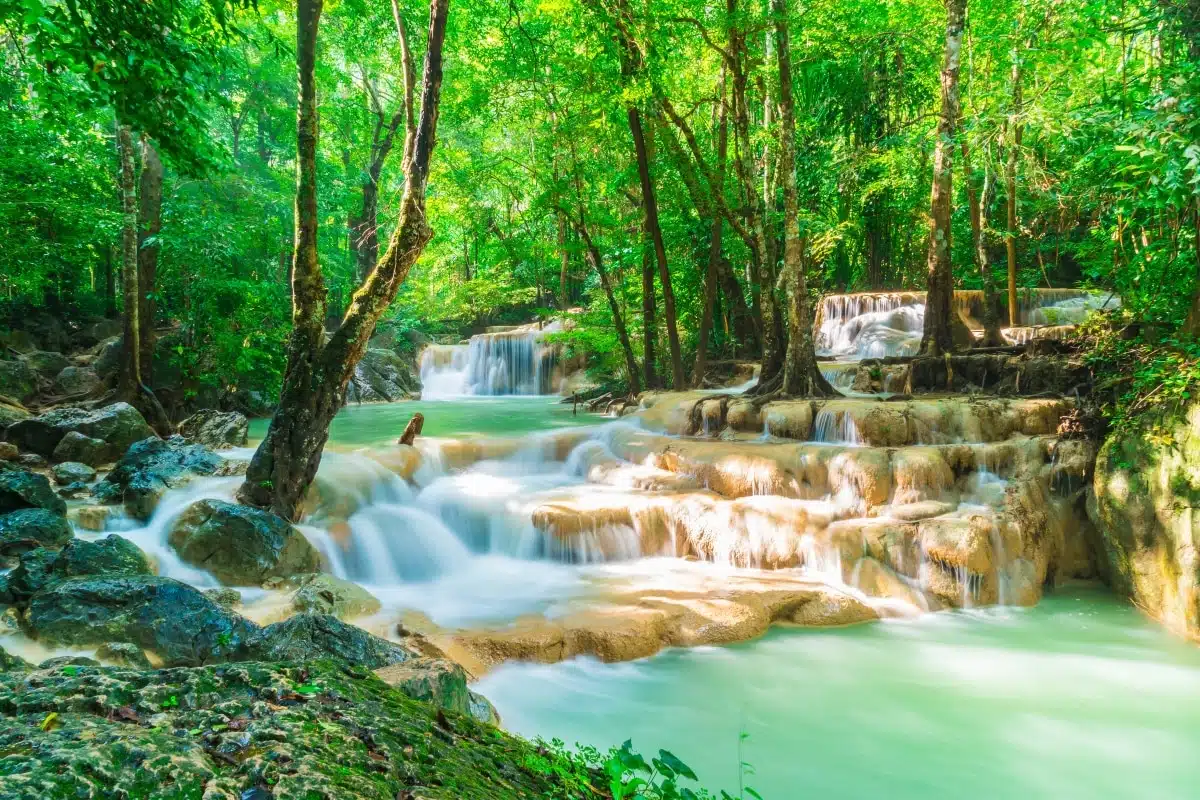Kanchanaburi is a province in Thailand where history and nature converge to create a blend of experiences that are as diverse as they are profound. The echoes of the past meet the tranquil beauty of the present. As you set foot in Kanchanaburi, you’ll find yourself in a region that’s not just geographically diverse but rich in historical significance. Known primarily for the Bridge Over the River Kwai, this area bears witness to a poignant chapter in World War II history, yet there’s so much more to explore and understand.
Kanchanaburi is a destination that demands exploration beyond the well-trodden paths. It’s a place where lush jungles and serene rivers create a backdrop for adventure and relaxation. From the somber history of the Death Railway to the natural splendor of Erawan National Park and the ancient ruins of Prasat Muang Singh, Kanchanaburi offers a journey through time and nature. As you read this guide, prepare to uncover the many layers of this fascinating province. Whether you’re a history buff, a nature enthusiast, or simply in search of a unique travel experience, Kanchanaburi is a destination that promises to engage, educate, and inspire.
1. The Bridge Over the River Kwai
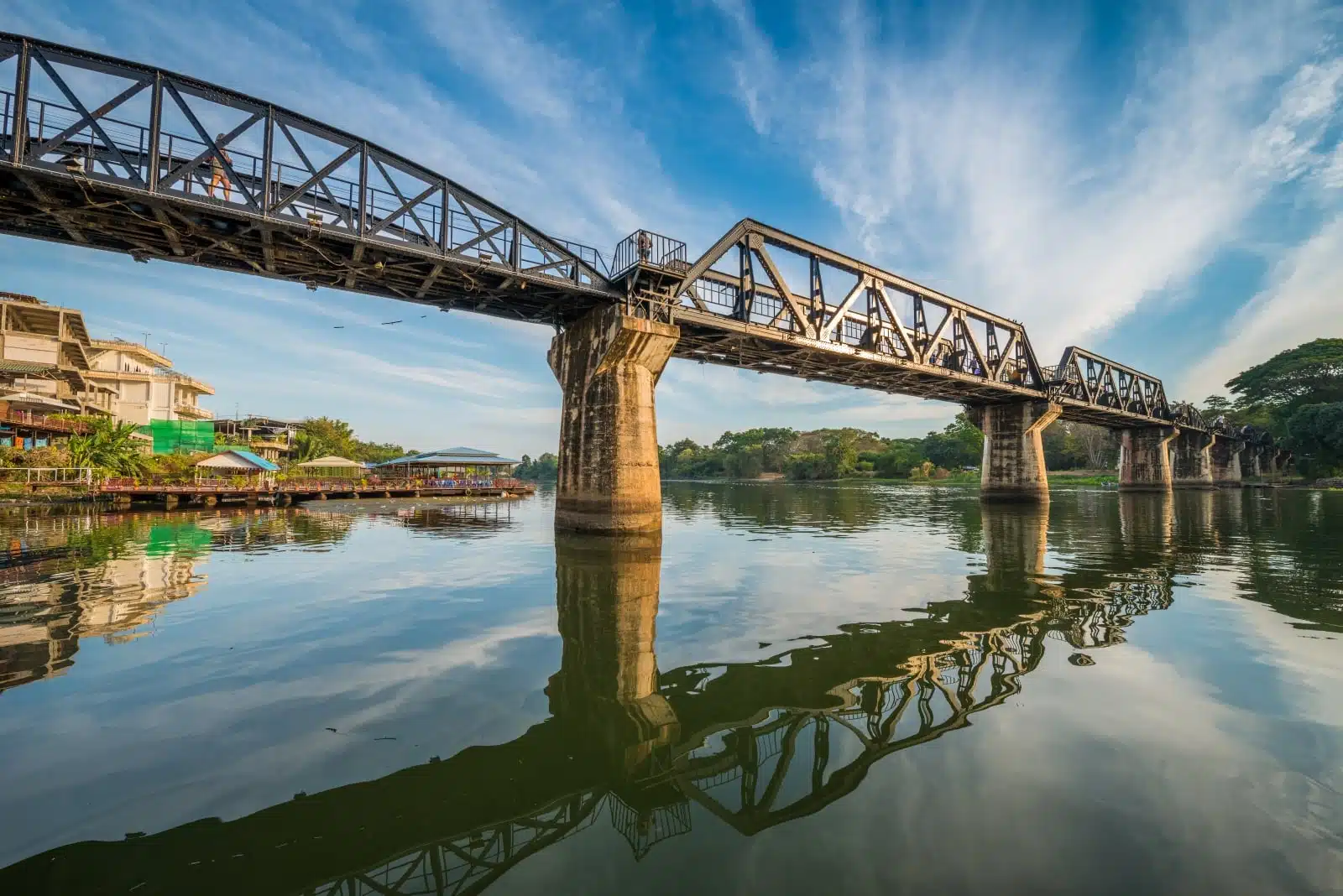
Image Credit: Shutterstock / Wuttichok Panichiwarapun
As you approach the Bridge Over the River Kwai, you’re stepping into a chapter of World War II history. This bridge, a part of the infamous Death Railway, was built under harrowing conditions by prisoners of war. Today, it is a poignant reminder of the resilience and suffering of those who built it. The structure, set against the picturesque River Kwai, offers a solemn yet beautiful scene. Nearby museums enrich your understanding, providing historical context to this iconic landmark. Walking across this bridge, you’re walking through history, each step a tribute to the past.
Insider’s Tip
Early mornings or late evenings are ideal for visiting to avoid the heat and crowds.
When To Travel
The cooler months from November to February are the best time to visit.
How To Get There
Kanchanaburi is accessible by bus or train from Bangkok, with the journey taking approximately 2-3 hours.
2. Erawan National Park
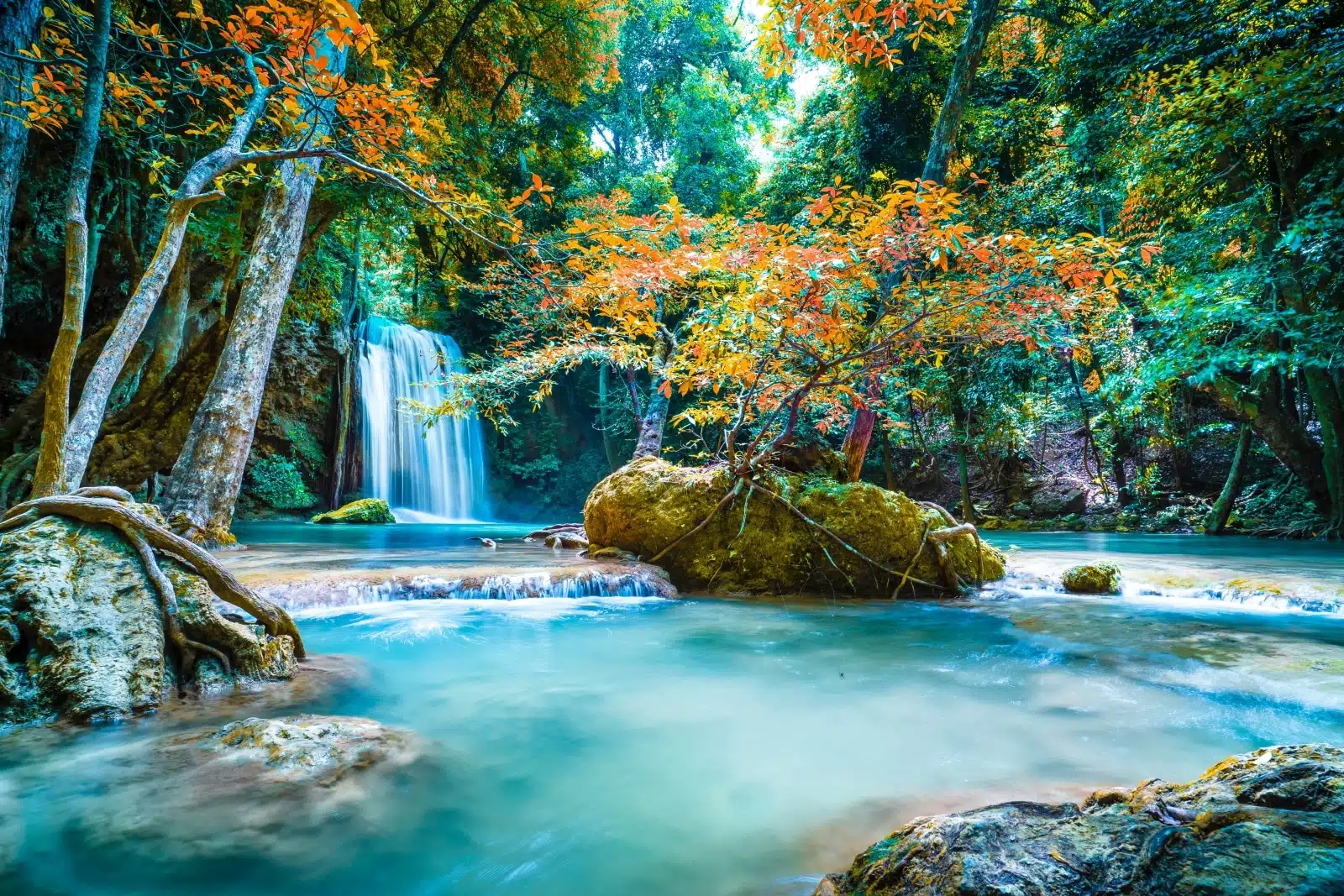
Image Credit: Shutterstock / Dpongvit
Discover the natural splendor of Erawan National Park, a jewel in Kanchanaburi’s crown. Famous for its seven-tiered waterfall, the park is a paradise for nature lovers and adventurers alike. The hike through dense jungle foliage leads you to each level of the waterfall, with each tier offering a unique and picturesque natural pool. The turquoise waters invite you for a refreshing swim, a welcome respite after the trek. The park’s diverse flora and fauna add to the magic, making it a perfect spot for relaxation and exploration. Whether you’re a photographer, a hiker, or simply needing tranquility, Erawan National Park delivers an unforgettable experience.
Insider’s Tip
Wear sturdy shoes for the hike and bring swimwear for the pools.
When To Travel
The best time is during the rainy season (May to October) when the waterfalls are at their fullest.
How To Get There
The park is about an hour’s drive from Kanchanaburi town, with public buses and tours available.
3. Hellfire Pass Memorial Museum and Walking Trail
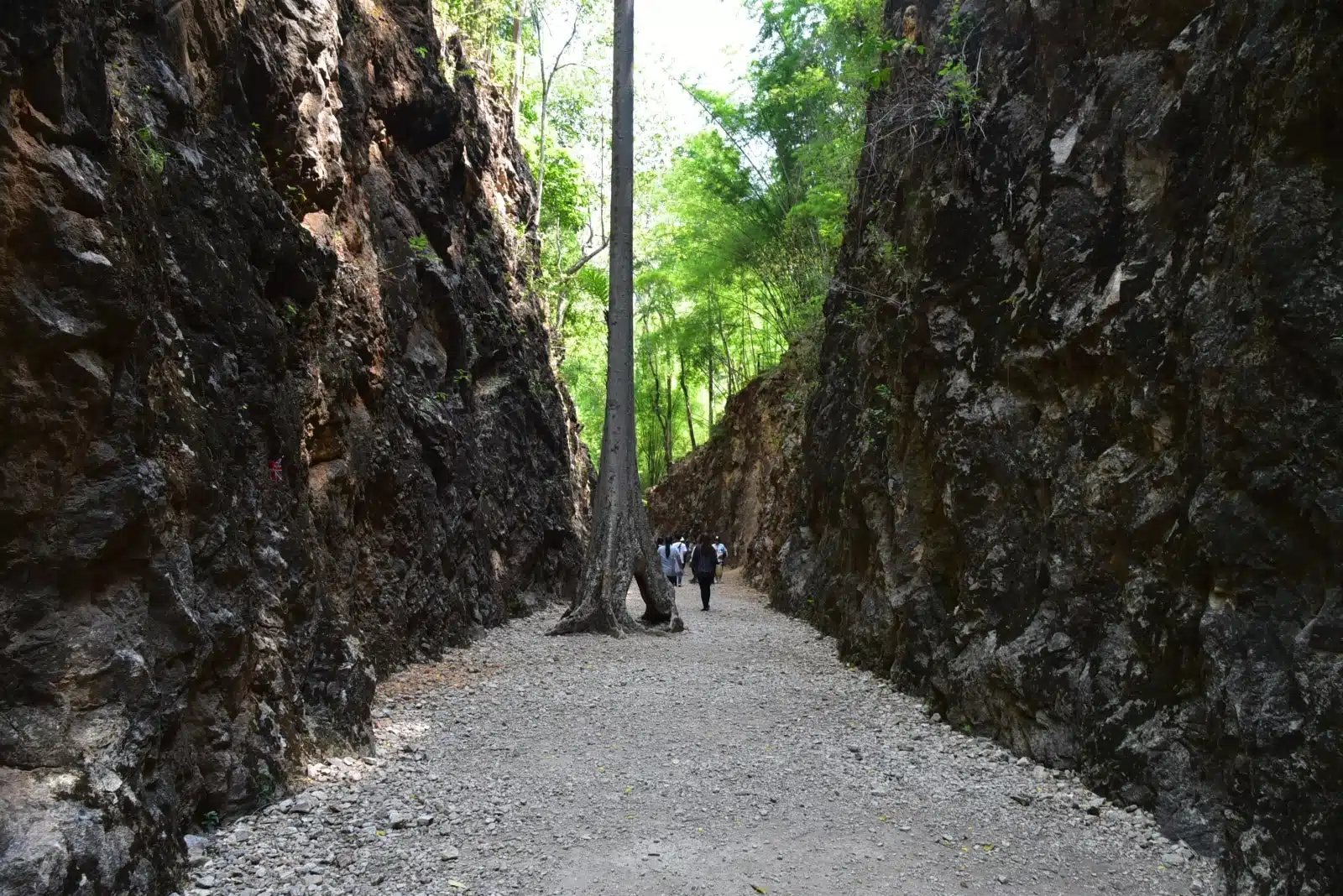
Image Credit: Shutterstock / Sutthi Chuvichit
Venture to the Hellfire Pass Memorial Museum and Walking Trail for a somber yet essential experience. This site, where POWs toiled to carve a path through solid rock, is a stark reminder of the harsh realities of war. The museum offers a comprehensive and respectful tribute to those who suffered, with detailed exhibits and narratives. The walking trail along the pass allows you to trace the footsteps of history, offering a moment of reflection amidst the scenic yet haunting landscape. You’ll understand the human cost of conflict, a poignant and moving experience that stays with you long after your visit.
Insider’s Tip
Carry water and wear comfortable shoes for the trail.
When To Travel
Visit in the cooler months for a more comfortable hike.
How To Get There
Located about 80 km from Kanchanaburi, it’s accessible by road; renting a car or joining a tour is recommended.
4. Sai Yok National Park
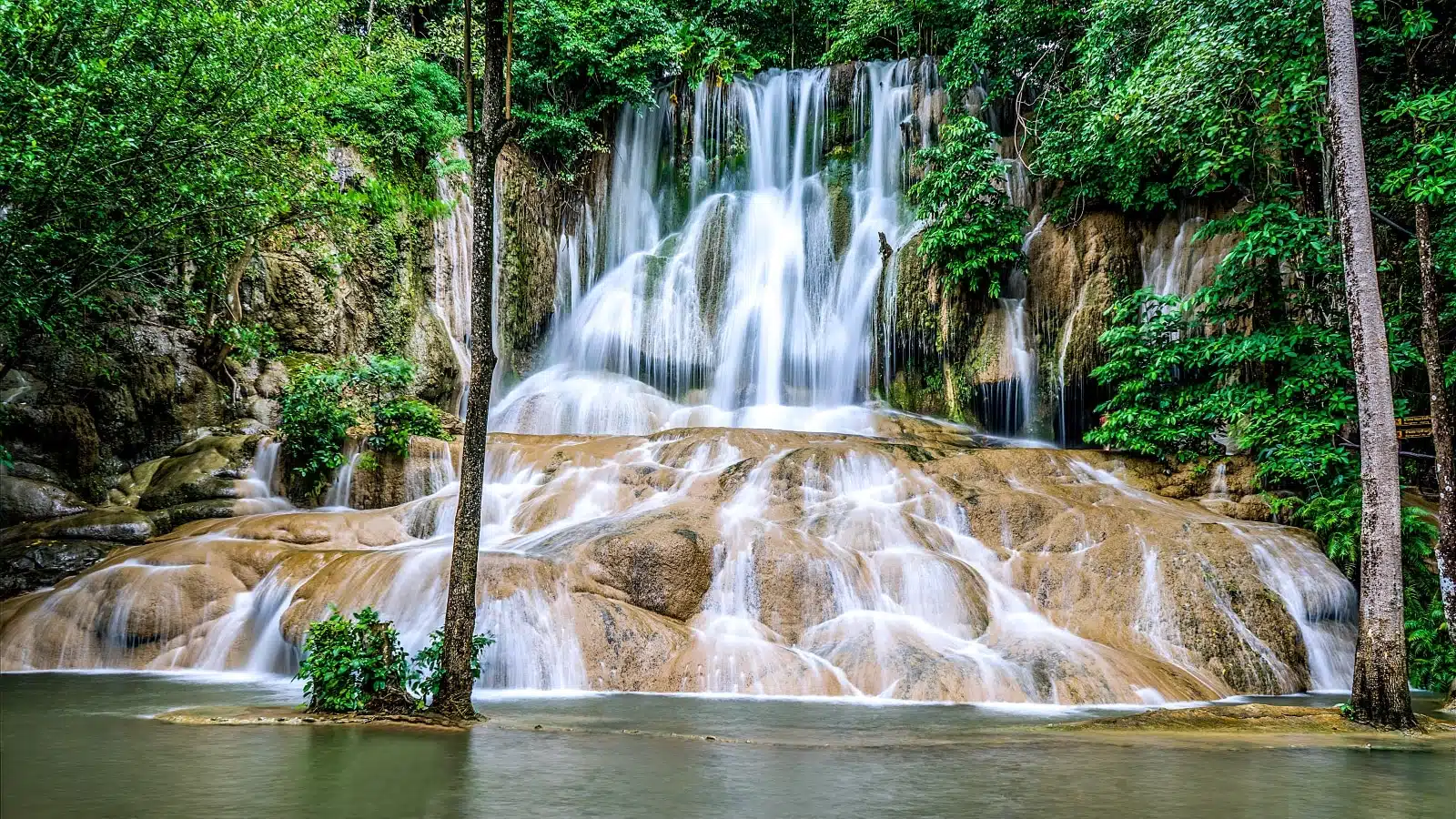
Image Credit: Shutterstock / TorTorTor
Explore Sai Yok National Park, a haven of natural beauty and historical significance. The park’s landscape is dotted with stunning waterfalls, including the renowned Sai Yok Yai, which flows into the Kwai Noi River. The park’s rich biodiversity and historical sites, such as remnants of the Death Railway, offer a diverse experience. Choose adventures in river rafting, wildlife spotting, or a peaceful nature retreat; Sai Yok National Park caters to all. The park’s serene environment and history make it a unique and enriching destination in Kanchanaburi.
Insider’s Tip
Rent a raft house on the river for an overnight stay to fully immerse yourself in the natural beauty.
When To Travel
The dry season from November to February is ideal for visiting.
How To Get There
The park is about a 2-hour drive from Kanchanaburi town. Public transport is limited, so consider renting a car or booking a tour.
5. The Death Railway
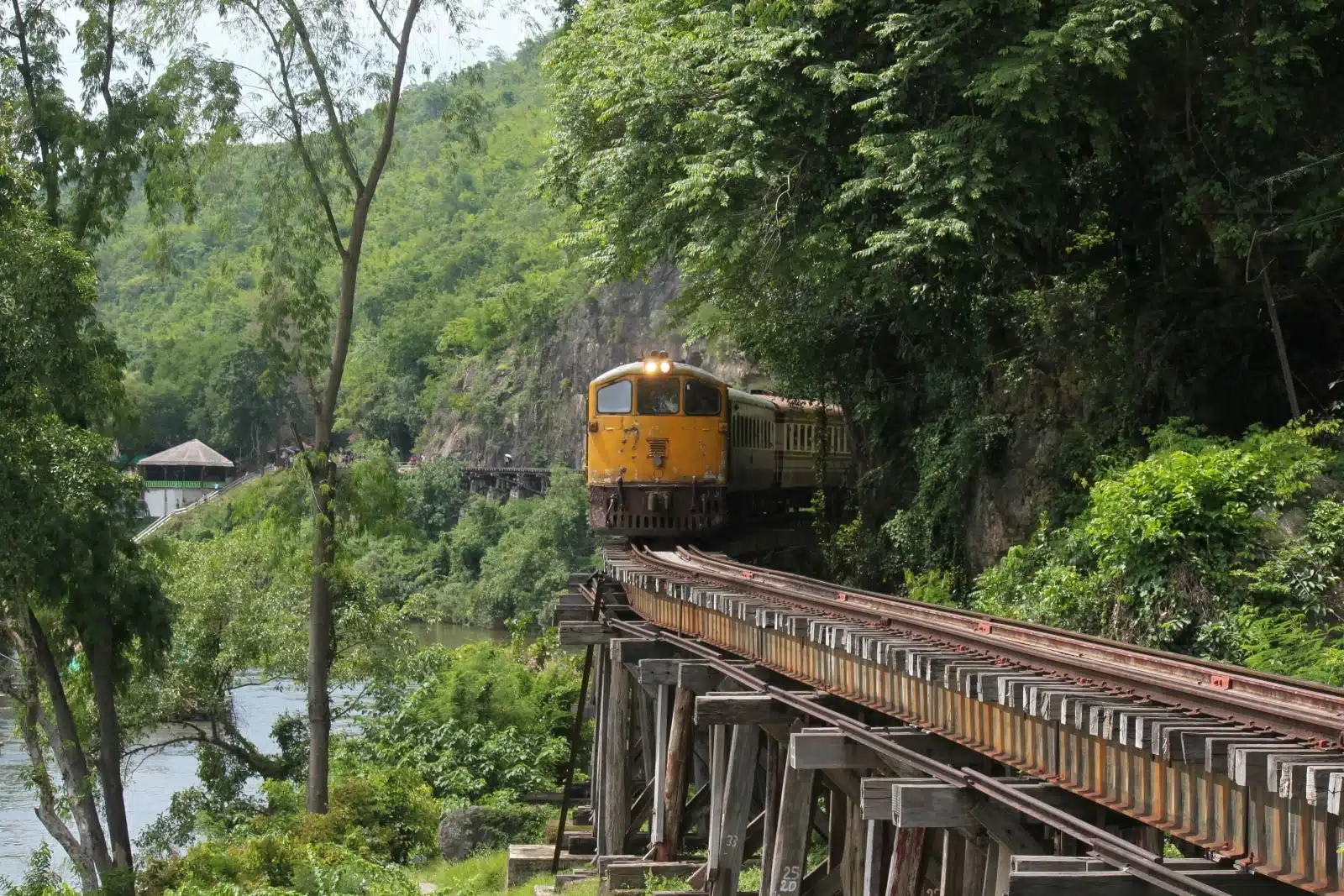
Image Credit: Shutterstock / Paraball
Embark on a historical journey along the Death Railway, a poignant reminder of World War II’s harsh realities. This railway, originally built by prisoners of war under brutal conditions is a moving historical experience. As the train snakes through the lush landscapes of Kanchanaburi, you’ll witness stunning views of the countryside and the River Kwai. The journey, particularly the passage over the original wooden viaducts, offers a unique perspective on the region’s past. The train ride is a journey through time, where every turn and every bridge has a story to tell. The train ride from Kanchanaburi to Nam Tok is both scenic and reflective, offering a chance to contemplate the sacrifices made in this very region.
Insider’s Tip
Choose a seat on the right side of the train for the best views.
When To Travel
Year-round, but mornings are preferable for cooler temperatures.
How To Get There
Trains depart regularly from Kanchanaburi’s main station.
6. Kanchanaburi War Cemetery
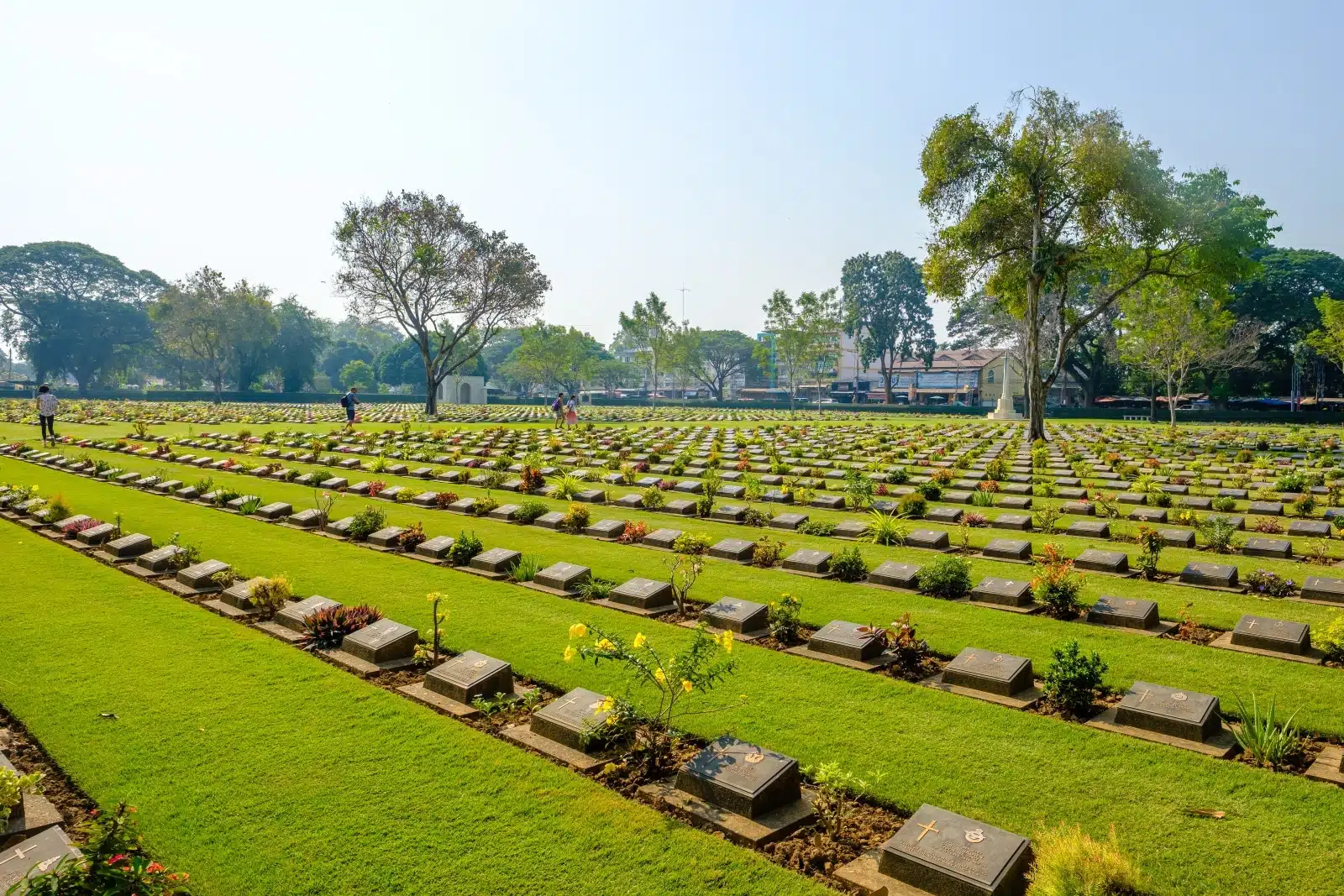
Image Credit: Shutterstock / patpitchaya
In Kanchanaburi War Cemetery, you’ll find a place of profound peace and respect. This meticulously maintained cemetery is the final resting place for over 6,000 Allied prisoners of war who lost their lives during the construction of the Death Railway. Each headstone tells a story of bravery and hardship, offering a space for reflection and remembrance. The cemetery, with its rows of white gravestones set against a backdrop of manicured lawns and tropical plants, starkly contrasts the turbulent history it represents. Pay your respects and understand the human cost of war and the enduring spirit of those who endured unimaginable hardships.
Insider’s Tip
Visit during the early morning or late afternoon for a quieter experience.
When To Travel
Open year-round, but the cooler months are more comfortable.
How To Get There
Located in Kanchanaburi town, it’s easily accessible on foot or by local transport.
7. Ban Kao National Museum
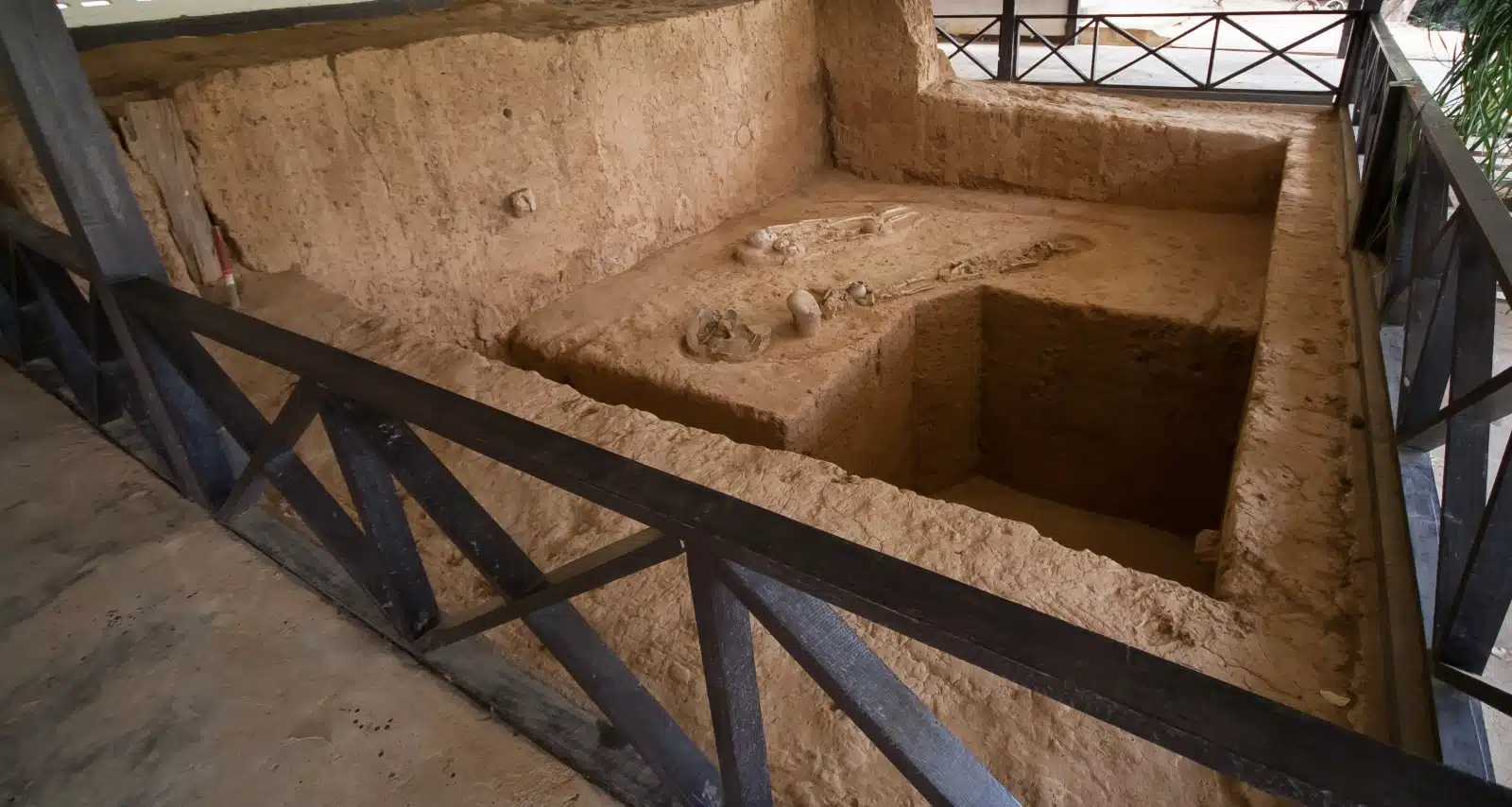
Image Credit: Shutterstock / Itsanan
Step into the Ban Kao National Museum, where you’ll be transported back to Kanchanaburi’s past. Though less frequented by tourists, this museum offers a fascinating glimpse into the region’s ancient history. The exhibits showcase artifacts from the Neolithic period, including pottery, tools, and skeletal remains, painting a vivid picture of early human life in this area. The museum contrasts Kanchanaburi’s WWII history and enriches your understanding of the region’s long-standing human narrative. As you wander through the displays, you’ll gain insights into the daily lives of ancient communities, their survival, and their artistry. The Ban Kao National Museum highlights Kanchanaburi’s diverse historical layers, making it a must-visit for those who appreciate the depth of human history.
Insider’s Tip
Don’t miss the outdoor exhibits for a complete understanding of the area’s ancient history.
When To Travel
Open year-round, but visit in the morning to avoid the heat.
How To Get There
Situated about 35 km from Kanchanaburi, it’s best reached by car or taxi.
8. Wat Tham Sua and Wat Tham Khao Noi
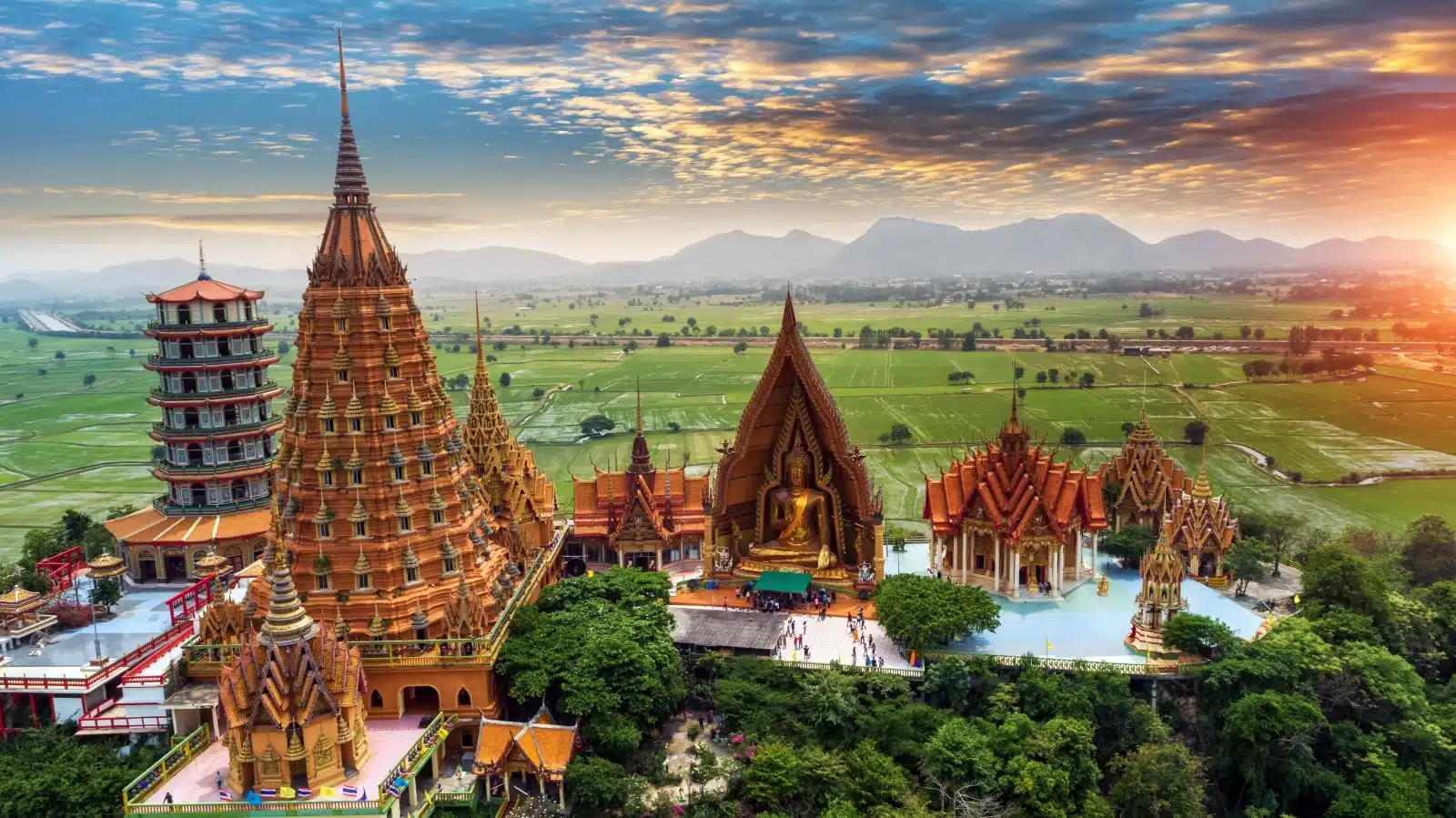
Image Credit: Shutterstock / Travel mania
As you ascend to Wat Tham Sua and Wat Tham Khao Noi, prepare for a spiritual and visual journey. These twin temples, perched atop hills, offer architectural beauty and panoramic views of the surrounding countryside. Wat Tham Sua is renowned for its imposing Buddha statue, while Wat Tham Khao Noi stands out with its striking Chinese-style pagoda. The climb to these temples is as rewarding as it is enlightening, offering a moment of tranquility and reflection. The serene atmosphere, combined with the breathtaking vistas, makes this a soul-stirring experience. These temples are sanctuaries where the spiritual and the earthly merge.
Insider’s Tip
Climb the stairs early in the morning to enjoy cooler temperatures and fewer crowds.
When To Travel
Visit any time of year, but mornings are best for the climb.
How To Get There
Located about 15 km from Kanchanaburi, these temples are accessible by car or taxi.
9. The River Kwai Jungle Rafts
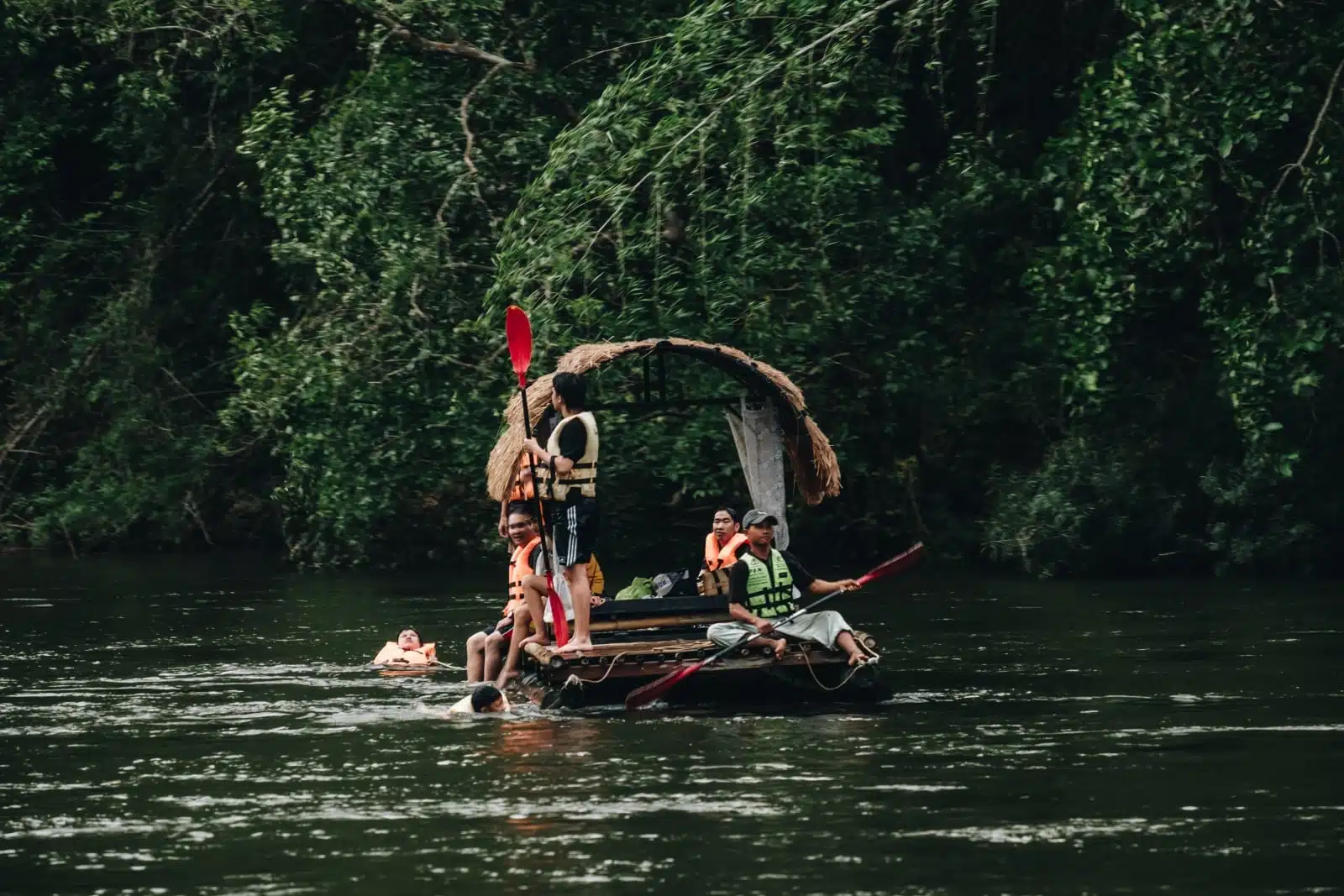
Image Credit: Shutterstock / nuu_jeed
Experience the River Kwai like never before on the unique Jungle Rafts. Floating on the serene waters, these eco-friendly accommodations offer a tranquil escape from the hustle of everyday life. The gentle flow of the river and the sounds of nature provide a soothing backdrop, making it an ideal spot for relaxation and contemplation. These rafts, devoid of electricity, encourage a genuine disconnect, allowing you to immerse yourself fully in the natural surroundings. It’s an opportunity to reconnect with nature and experience the river’s calming influence.
Insider’s Tip
Choose a raft without electricity for a truly off-the-grid experience.
When To Travel
Best visited in the dry season for river stability.
How To Get There
Located downstream from Sai Yok National Park, accessible by boat from local piers.
10. Prasat Muang Singh Historical Park
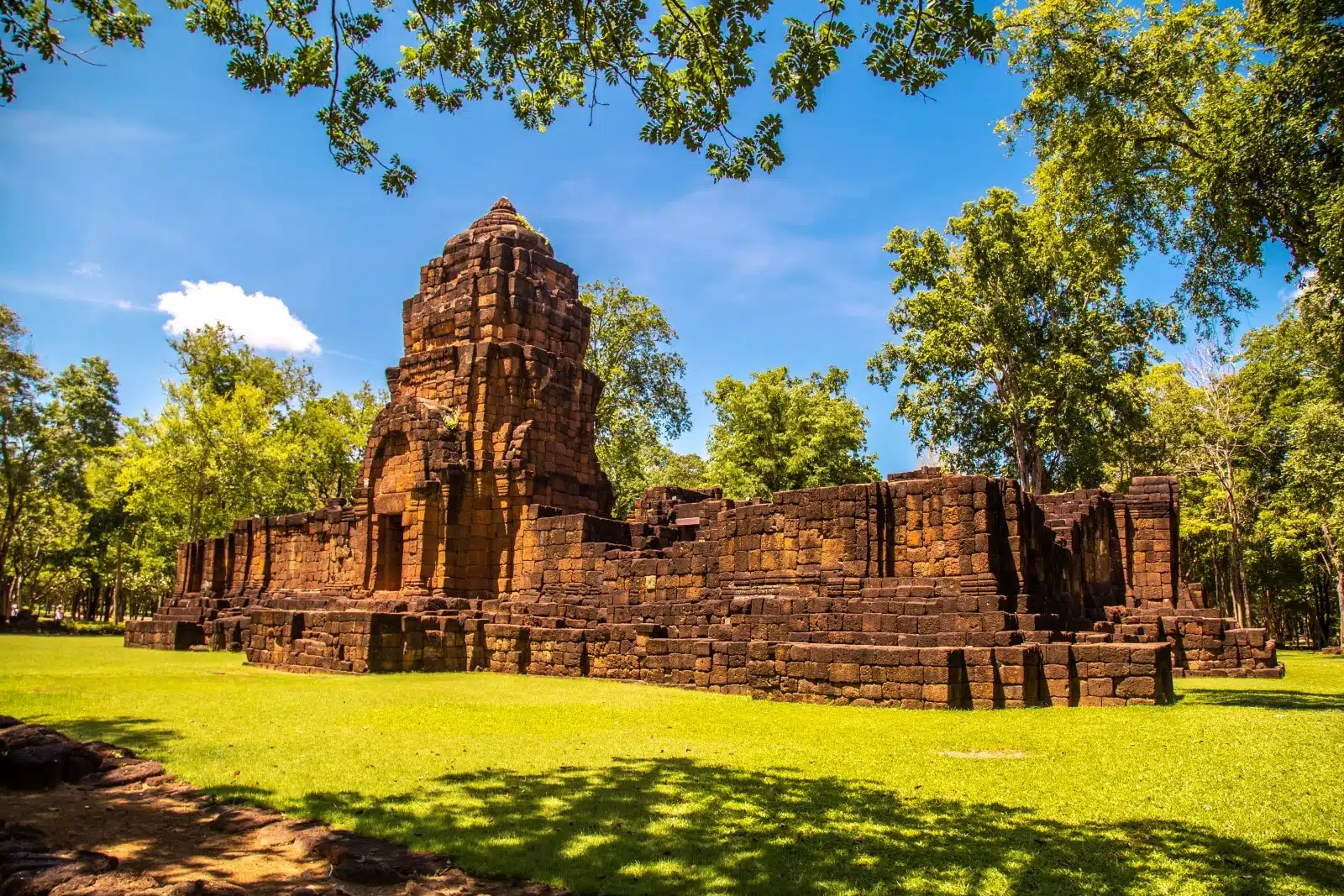
Image Credit: Shutterstock / lemaret pierrick
Discover the ancient secrets of Prasat Muang Singh Historical Park, where history and nature intertwine. This historical site, set along the banks of the Kwai Noi River, features ruins from the Khmer Empire, offering a glimpse into a civilization that once thrived here. The park’s serene setting, with its ancient structures and lush greenery, provides a peaceful escape. As you explore the ruins, you’ll walk through centuries of history, each stone and carving a testament to the park’s historical significance. Prasat Muang Singh is a journey into the past, offering a unique perspective on the region’s cultural heritage.
Insider’s Tip
Late afternoon visits allow for cooler exploration and beautiful sunset views.
When To Travel
Visit any time of year, but the cooler months offer a more comfortable exploration experience. How To Get There
The park is about 40 km from Kanchanaburi town, accessible by car or local bus.
Travel Tips for Kanchanaburi
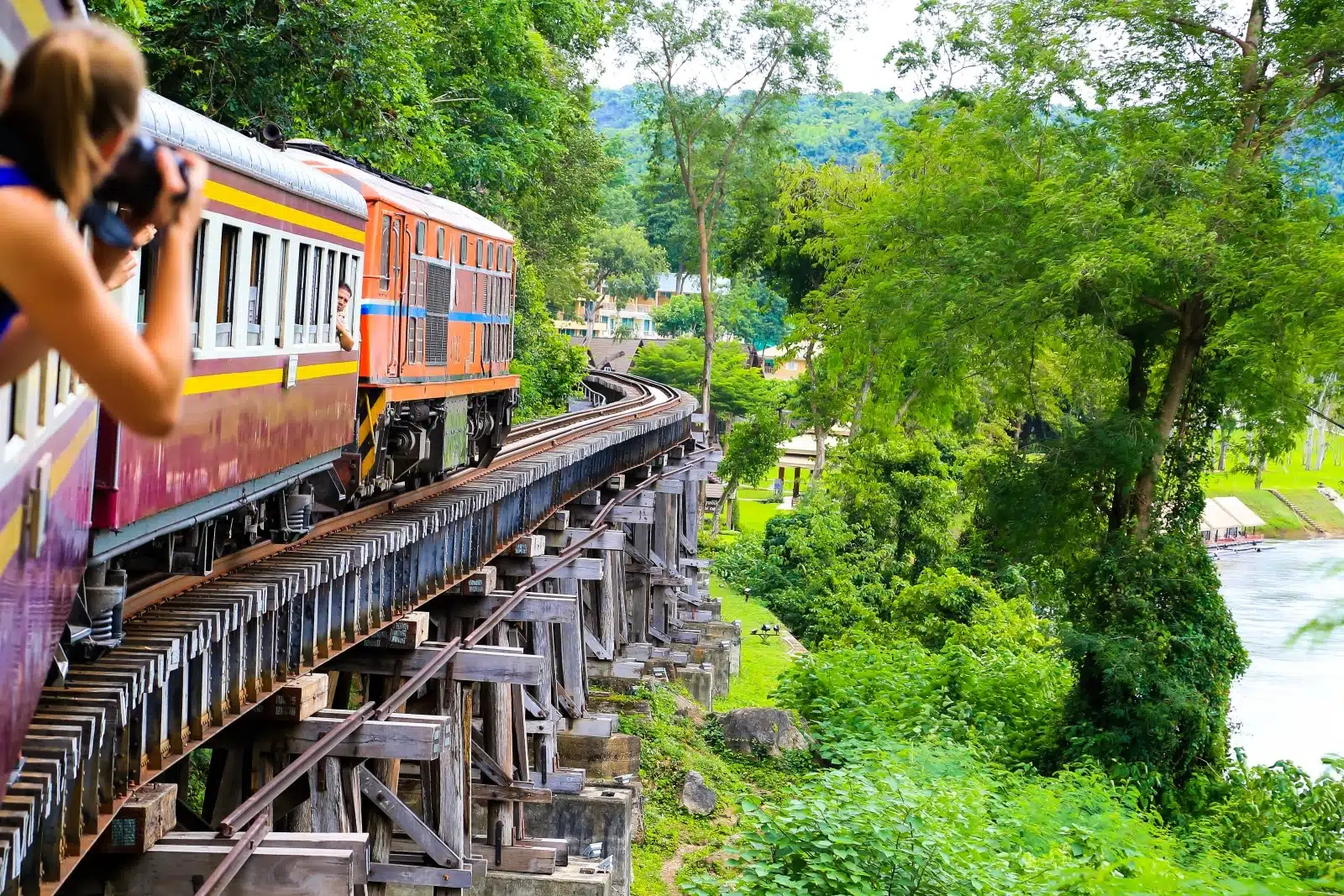
Image Credit: Shutterstock / Wila_Image
- Stay Connected: While exploring remote areas, carry a local SIM card for better connectivity.
- Cash is King: Many places in Kanchanaburi, especially in rural areas, do not accept credit cards. Carry enough cash for your expenses.
- Respect Local Customs: Be mindful of Thai customs and traditions, especially in temples and rural communities.
- Stay Informed: Check local news for any travel advisories or updates, especially during the rainy season.
- Pack Appropriately: Bring light, breathable clothing, but also pack a raincoat or umbrella during the rainy season.
- Health Precautions: Carry a basic first-aid kit and any personal medications you might need.
- Be Environmentally Conscious: Respect the natural environments, especially in national parks and near waterfalls.
- Safety First: Always follow safety guidelines, especially when engaging in outdoor activities like hiking or rafting.
- Local Guides: Consider hiring local guides for in-depth exploration and insights into the history and culture.
- Plan Ahead: Some attractions may require advance booking, especially during peak tourist seasons.
The Bottom Line
As you embark on your journey to Kanchanaburi, remember that you’re stepping into a region rich in history and natural beauty. From the haunting memories of the past at the Bridge Over the River Kwai to the serene cascades of Erawan Falls, each destination offers a unique experience. Embrace the adventure, respect the history, and immerse yourself in the natural wonders of this captivating region. Kanchanaburi is a journey through time and nature that promises to leave you with lasting memories. So pack your bags, set your itinerary, and get ready to explore the wonders of Kanchanaburi.
More From The Green Voyage
Top 10 Trending Travel Destinations 2024
6 Essential Banking Apps for International Travel – Managing Your Finances on the Go
Traveling With Kids – 10 Tips to Create Memorable Family Holidays
The post 10 Travel Tips to Explore Kanchanaburi and the Bridge Over the River Kwai 2024 first appeared on The Green Voyage.
Featured Image Credit: Shutterstock / gowithstock.
Tips for Trip Success
Book Your Flight
Find an inexpensive flight by using Kayak, a favorite of ours because it regularly returns less expensive flight options from a variety of airlines.
Book Your Hotel or Special Accommodation
We are big fans of Booking.com. We like their review system and photos. If we want to see more reviews and additional booking options, we go to Expedia.
You Need Travel Insurance!
Good travel insurance means having total peace of mind. Travel insurance protects you when your medical insurance often will not and better than what you get from your credit card. It will provide comprehensive coverage should you need medical treatment or return to the United States, compensation for trip interruption, baggage loss, and other situations.Find the Perfect Insurance Plan for Your Trip
